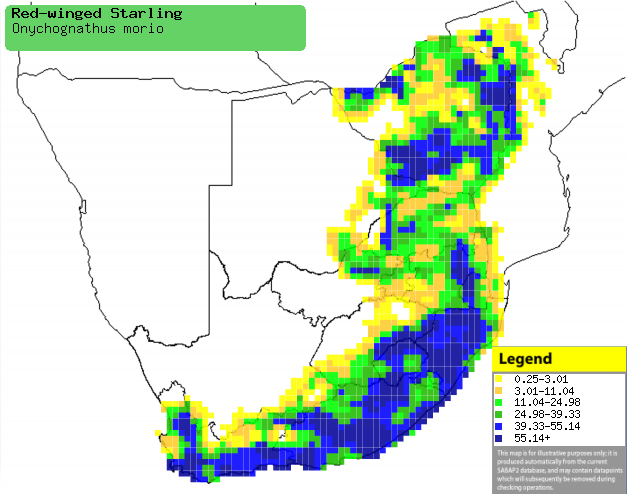|
Onychognathus morio (Red-winged
Starling)
Rooivlerkspreeu [Afrikaans]; Isomi
[Xhosa]; iNsomi, iSomi [Zulu]; Letšoemila, Letšomila [South Sotho]; Gwitso [Shona];
Roodvleugelspreeuw [Dutch]; Rufipenne morio [French]; Rotschwingenstar [German];
Estorninho-d'asa-castanha [Portuguese]
Life
> Eukaryotes >
Opisthokonta
> Metazoa (animals) >
Bilateria >
Deuterostomia > Chordata >
Craniata > Vertebrata (vertebrates) > Gnathostomata (jawed
vertebrates) > Teleostomi (teleost fish) > Osteichthyes (bony fish) > Class:
Sarcopterygii (lobe-finned
fish) > Stegocephalia (terrestrial
vertebrates) > Tetrapoda
(four-legged vertebrates) > Reptiliomorpha > Amniota >
Reptilia (reptiles) >
Romeriida > Diapsida > Archosauromorpha > Archosauria >
Dinosauria
(dinosaurs) > Saurischia > Theropoda (bipedal predatory dinosaurs) >
Coelurosauria > Maniraptora > Aves
(birds) > Order: Passeriformes
> Family: Sturnidae > Genus: Onychognathus
Distribution and habitat
Occurs in patches from Ethiopia through Kenya, Tanzania and
Malawi to southern Africa. Here it is common from northern Mozambique and
Zimbabwe to eastern Botswana and South Africa (as well as Lesotho and
Swaziland), while absent from the Karoo and Kalahari. It generally prefers rocky
outcrops and gorges in highland grasslands, occasionally visiting forests for
fruit, but in recent times it has flourished in urban areas, roosting and
nesting in buildings.
|
 |
|
Distribution of Red-winged starling in southern Africa,
based on statistical smoothing of the records from first SA Bird Atlas
Project (©
Animal Demography unit, University of
Cape Town; smoothing by Birgit Erni and Francesca Little). Colours range
from dark blue (most common) through to yellow (least common).
See here for the latest distribution
from the SABAP2. |
Predators and parasites
Eggs and fledglings have been recorded as prey of the
following animals:
- Birds
- Mammals
- Papio ursinus (Chacma baboon)
Brood parasites
It has been recorded as host of the
Great spotted cuckoo.
General Habits
In Summer breeding pairs avoid other pairs,
roosting at their own nest site. However, in Winter it forms large
flocks of up to around 500 birds, which often roost communally in
trees, cliffs and buildings. It can cause serious problems for
people living in buildings used as roost sites, as the starlings
make a lot of noise and may attack human residents.
Food
It mainly eats fruit supplemented with arthropods,
nestlings and lizards, foraging on the ground and in vegetation, gleaning food
from leaves and branches. It is an extremely adaptable feeder, as it removes
ticks from antelope, picks up scraps at picnic sites, takes food from the
intertidal zone and scavenges meat off carcasses. The following food items have been recorded
in its diet:
- Fruit
- Animals
- arthropods
- molluscs
- freshwater crabs
- birds
- lizards
- frogs
- Miscellaneous
- human food scraps
- carrion
Breeding
- It is monogamous with pairs staying together for several years, possibly
life, often producing two broods in one breeding season.
- The nest is built by both sexes, consisting of a large flat platform
built of sticks, grass and rootlets secured together with mud. The interior
is usually lined with grass or other fine material, such as horse or even
human hair, plucked from peoples' heads. It is typically placed on a rock or
building ledge, on beam or at the base of a palm frond; it has also been
recorded to use a wrecked fishing trawler 200m offshore and a broadcasting
tower at the University of Cape Town.
- Egg-laying season is from September-March.
- It lays 1-5 eggs, which are incubated mainly by the female for about
13-14 days, while the male feeds her at the nest.
- The chicks are fed by both parents on a diet of pieces of insects,
leaving the nest after about 22-28 days. The first brood of the breeding
season are usually chased away by their parents about 2 weeks later, but the
second brood may remain dependent on the adults for 5-6 weeks after leaving.
Threats
Not threatened.
References
-
Hockey PAR, Dean WRJ and Ryan PG 2005. Roberts
- Birds of southern Africa, VIIth ed. The Trustees of the John Voelcker
Bird Book Fund, Cape Town.
|
